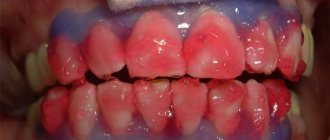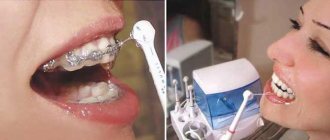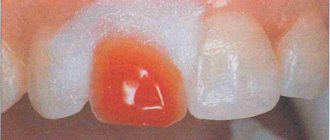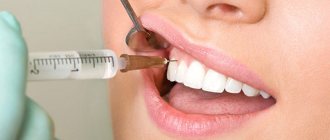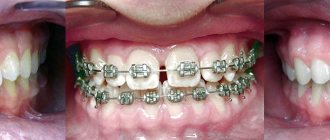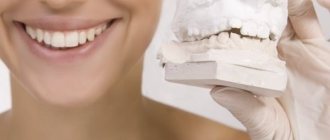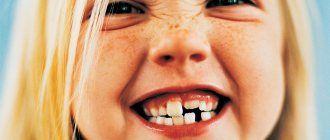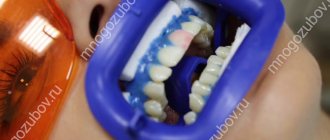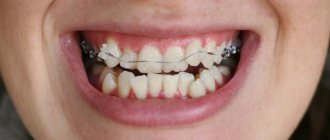What are braces and what are they for?
A braces system, or simply braces, is a non-removable structure that allows you to straighten your teeth or correct your bite, regardless of age. The system consists of an arch and clasps, which, thanks to a special glue, are attached to the teeth. Braces are made from different metals or alloys, are characterized by several types of fastening, and also oblige the patient to observe special rules of oral hygiene.
Young girl with braces
How to make fake braces yourself
To make fake braces, you can use a large paper clip and use it as a wire after bending it into a U shape. This will look like the metal wire that is traditionally placed around teeth. You can then use colored beads on wire to create the look of brackets.
When assembling these braces yourself, be careful not to tighten the wires too tightly on your teeth to avoid damaging them. We recommend being very careful with homemade fake braces in your mouth and it is best to try not to eat or drink anything while wearing them. It is not recommended to make such devices yourself if you cannot follow the safety rules in them. You can always buy a ready-made device, which is much safer than a homemade one.
Indications and contraindications for installing braces
Indications
- Various degrees of bite deformation;
- Crowding of teeth;
- Excessive development of one jaw relative to the other;
- Dystopia – incorrect position of one or more teeth;
- Eliminating gaps between teeth.
Contraindications
- Absence of a large number of teeth;
- Weak teeth;
- Periodontitis;
- Bruxism (teeth grinding);
- Immune system diseases;
- Oncology;
- Disease of the skeletal system, in which there is a low level of its healing;
- Tuberculosis, HIV, sexually transmitted diseases;
- Allergy to any materials.
When is the best time to start wearing braces?
It is impossible to answer the question posed unambiguously. Each case is individual. Usually the most suitable age is 10-12 years. It is at this time that the child’s active growth occurs, as well as the completion of the formation of the bite. Thus, wearing a brace system will give a good and quick effect.
Depending on the case, the doctor may prescribe treatment at an earlier age, and sometimes at 17-18 years of age. Everything is quite individual.
Photos before and after braces
When choosing the optimal age for installing and wearing braces, it is worth considering:
- The degree of malocclusion;
- Condition of tooth enamel;
- General development of the patient;
- Willingness/unwillingness to wear braces;
- Level of oral hygiene.
It would be a good idea to visit an orthodontist at the age of 3-4 years, when the primary dentition is fully formed. This will allow you to determine in advance whether the child has any problems and how to solve them.
There are three main periods for orthodontic treatment:
Early treatment
Between the ages of 5 and 10 years. During this period, to change the bite or straighten the teeth, removable “plates” structures and elastic mouthguards – trainers – are installed. In special cases, “partial braces” are used.
However, it is worth noting that treatment is considered complete only after all permanent teeth have erupted. Thus, treatment can last from 5-6 years to 14-15, which can lead to unpleasant consequences (the child will get tired of wearing braces for so long). Therefore, starting early treatment should only be done if absolutely necessary.
Treatment during adolescence
11-12 years old. This age is the most favorable for orthodontic treatment. Because This is a time of active growth for the child, solving bite problems and straightening teeth occurs faster and better. Usually at this age a brace system is installed.
Since this orthodontic structure is non-removable, great attention should be paid to oral hygiene.
Treatment for adults
Over 18 years old. Treatment with braces is effective regardless of the patient’s age. However, there are still some differences in teeth alignment and bite correction.
Braces for an adult
Unfortunately, with age, the general condition of teeth worsens. The patient faces problems such as fillings in teeth (some teeth are pulpless), tooth extraction, chronic gum disease - periodontitis. The condition of the body as a whole may also deteriorate. All this can lead to lengthy and not always high-quality treatment.
The basis of treatment is also braces.
Can I eat meat with braces?
Eating meat can indeed become a problem during treatment. For example, fibers from tough, stringy meat can get stuck in your braces, and enjoying chicken wings or pork ribs can easily lead to broken parts.
To avoid creating problems for yourself, you should give preference to lean, soft meat, cut into small pieces, and be sure to separate it from the bones before eating. With this approach, you can even eat meat cooked over an open fire - shish kebab and barbecue.
If difficulties still arise, the meat should be prepared in the form of meatballs or pates. Soft-cooked fish and tofu can also be sources of protein.
| Doctor: Sudzhaev Sergey Romanovich Patient age: 25 years Diagnosis: distal occlusion, transversal incisal occlusion, crowding of the frontal sections of the upper and lower dentition, edentulous teeth 1.4;2.4;3.4;4.4. Duration of treatment: 12 months Equipment: Clarity SL bracket system | TO THE DOCTOR |
| BEFORE | AFTER |
Pros and cons of braces
Pros:
- The main benefit is the ability to correct any pathology associated with the position of the teeth, regardless of age;
- Achieving a beautiful, and most importantly healthy smile. Thanks to the braces system, after 2-3 weeks of treatment, positive changes in the position of the teeth are visible.
- Absolute absence of any age restrictions. The only limitation may be the poor condition of the teeth and gums.
Minuses:
- Oral hygiene becomes more difficult. The patient should brush his teeth more thoroughly. If hygiene is not taken seriously, the accumulation of plaque can lead to caries, gingivitis and other diseases of the teeth and gums.
- Most patients are put off by the length of time they wear braces. Treatment can last from several months to 3 years. Not everyone will agree.
- High cost of braces. Basically, the price depends on the material from which the clasps and arches are made, the duration of treatment, as well as the qualifications of the orthodontist.
- The harm from braces may include increased vulnerability of tooth enamel to the threat of caries.
Lingual brace system
This is a type of orthodontic structures (they are also called invisible) that are attached to the inside of the teeth. This type of braces is popular among movie and pop stars.
How are lingual braces positioned?
Advantages:
- Absolutely invisible, because attached to the inside of the teeth;
- Do not injure the tissues of the oral cavity, namely: cheeks, gums and lips;
- With their help it is possible to correct a deep bite;
- Virtually eliminate the possibility of damage to tooth enamel;
- Allergy sufferers can also wear them, because... Gold may be used in the manufacture of lingual structures.
Flaws:
- May affect diction in the first 2-3 weeks of wearing;
- Possible injury to the tongue and excessive salivation;
- Production time is about 2 months;
- Compared to vestibular (those that are attached to the front of the teeth) braces, lingual braces are difficult to care for;
- The duration of treatment increases by 3-4 months;
- Quite a high price;
- There are more contraindications than for regular ones.
Ceramic bracket system
Consists of the same elements as regular metal. The material for the manufacture of this type of braces is polycrystalline or monocrystalline ceramics.
ADVANTAGES:
- Aesthetics. The color of the ceramics is similar to the enamel of teeth, which ensures that the system is invisible.
- Hypoallergenic. Ceramic braces can be installed in patients with hypersensitivity to metals;
- Thanks to the smooth surface and rounded shape, the possibility of injury to the cheeks, gums and lips is eliminated.
- High strength;
- resistance to coloring substances contained in food; do not turn yellow over time.
Sapphire and ceramic braces
DISADVANTAGES:
- Quite a high cost;
- The duration of treatment increases by 3-4 months;
- Due to the tight fit of the bracket to the tooth enamel, demineralization and destruction are possible.
If the braces are external, diction remains virtually unchanged
Commented by orthodontist, candidate of medical sciences Tatyana Gevorkyan
— Very often patients are puzzled by the issue of diction when wearing braces. And this doesn't only apply to adults. Almost all schoolchildren study a foreign language, and pronunciation is very important there.
This diction myth is wrong. External vestibular braces do not affect diction, since they are fixed on the outer surface of the teeth, while the tongue is located on the inside. Internal – lingual – braces “sin” with impaired diction (albeit temporarily). This is where you really need to get used to the innovations on your teeth for some time.
Are braces harmful to teeth?
For 20 years, clinical research and technological capabilities have improved orthodontic treatment. Thanks to this, wearing modern braces is absolutely safe.
However, patients may encounter certain difficulties:
- Discomfort. After installing the braces, the patient will feel discomfort. The degree of discomfort directly depends on the pain threshold. Usually the patient feels a slight pain in the teeth and gums.
- Poor oral hygiene can lead to gum disease and tooth decay. People often assume that braces leave stains on the teeth or damage the enamel, and also lead to swelling of the gums. It is a myth. The patient should remember to brush his teeth thoroughly, use dental floss and a brush to clean the system. In this case, there will be no problems with your teeth.
- Root resorption is the reduction of tooth roots. It is difficult to determine whether braces had an effect in one case or another, because... Root resorption can occur without orthodontic treatment. Some people are predisposed to this.
Consequences of wearing braces
After completing treatment with braces, the patient may experience complications. If during the treatment the teeth did not have enough calcium, after removing the system, stains may appear on the teeth, i.e. foci of demineralization. Following this, caries appears. A gum pocket may also appear.
You need to understand that the condition of the teeth after removing braces depends entirely on the level of oral hygiene during the treatment itself.
In addition, an experienced orthodontist must not only select the right material and design, but also carefully examine the patient’s oral cavity during each visit. This way you can avoid complications.
Based on the foregoing, it should be noted that braces are the best treatment method in orthodontics. Of course, there are disadvantages. However, the result is worth it. Treatment with braces gives effective results. Even the most complex problems of bite and crooked teeth can be corrected thanks to modern orthodontic structures.
